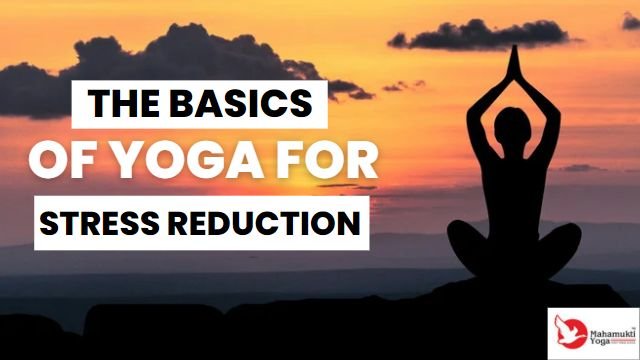Yoga for stress reduction is continuing to grow its popularity due to its many physical and mental benefits, such as reducing stress and anxiety. By doing a personal yoga practice is a great way to focus on self-improvement and creates positive growth in person’s life.
In addition to physical postures, your yoga routine can include breathing exercises, meditation, and relaxation techniques like yoga nidra. Practicing some of these techniques can improve your mental and physical well-being by helping to reduce stress and anxiety. By practicing yoga into your daily routine, you can experience improved health, good peace of mind, and a very balanced life.
Also Read: Do you want to Become a Yoga teacher
Yoga Poses for Stress Relief
You can get started with the following yoga for stress reduction poses.
Child’s Pose (Balasana)

This pose is very helpful for mental and physical relaxation.
- From a kneeling position, keep your knees together or slightly apart.
- From this position, sit back on your heels.
- Now hinge at your hips and fold forward, resting your forehead on your mat.
- Then extend your arms in front of you or alongside your legs.
- Allow your torso to rest on your thighs.
- Take a deep breath and focus on allowing your body to relax.
- Remain in this pose for up to 5 minutes.
Cat-Cow Pose (Marjaryasana to Bitilasana)

Here’s how you do the Cat Cow Pose.
- Start by sitting on the ground, with your knees bent and your hands and feet flat on the floor.
- Begin by sitting on the ground, with your knees bent directly beneath your hips and your hands flat on the floor, directly beneath your shoulders.
- While inhaling, look towards the ceiling and lift your chest and belly, arching your back. This is Cow Pose.
- As you exhale, tuck your chin toward your chest and arch your back up toward the ceiling, like a stretching cat.
- Continue to alternate between these two positions for 1 minute.
Also Read: Best Yoga Retreat In Goa
Legs-Up-the-Wall Pose (Viparita Karani)

Some steps to do Legs Up the Wall pose for stress relief
- Sit on the floor while facing a wall, and with your back pressed up against it.
- Lie down on your back with your legs against the wall, keeping your knees straight.
- Now position your hips close to the wall.
- Place your arms alongside your body, or put one hand on your stomach and the other one on your chest.
- Hold this yoga pose for about 15 minutes.
Corpse Pose (Savasana)

This is one of the best yoga for stress relief
- Lie on your back with your feet wider than your hips.
- Allow your toes to spread out little to the sides.
- Place your arms next to your body at a 45-degree angle.
- Position your head, neck, and shoulders in alignment with your spine.
- Take deep breaths as you allow your body to fully relax.
- Remain in this posture for about 10–20 minutes.
Yoga meditation for Stress Relief
You can practice meditation on its own or include it as part of your asana routine. Meditation positions include sitting on a chair or on the floor, standing, walking, and lying-down.
Make a consistent meditation practice by experimenting with different kinds of meditation. Try exploring different techniques by your own or take the guidance of a teacher who can help you to create a structured routine. Once you’ve maintained a regular practice, try sticking to it for some time instead of regularly changing your routine.
Yoga nidra, sometimes referred to yogic sleep and is a form of guided meditation. It is very effective relaxation technique that helps to reduce stress, improve sleep, and encourage deep relaxation.
Yoga nidra is a fantastic option when you’re too tired for an asana (moving through poses) or seated meditation practice but still want to dedicate time to your yoga routine.
Tips while doing Yoga for Stress Relief
- Firstly, start with doing some deep breathing exercises to calm your body and mind.
- Focus on your breath, and don’t get diverted by thoughts or feelings.
- Allow yourself to relax into the pose and let go of any tension or stress.
- Picture yourself in a calming and peaceful place.
- Always choose poses which are calming and restorative.
- Move very slowly and delicately.
- Notice the sensation of the poses and how it affects your mind and body.
- Work on letting go of all the negative thoughts or energy.
- Always ends the practice with a few moments of meditation.
Benefits of Yoga for Stress Reduction
- Relaxes the Mind: Yoga can help alleviate stress by calming the mind and body, utilizing meditation and deep breathing to achieve a tranquil state and allow worries and anxieties to dissipate.
- Increases Flexibility: Yoga can help to reduce the tension that builds up in the body due to stress by improving flexibility.
- Boosts Self-Confidence: By practicing yoga, one can gain increased self-confidence, which can help to reduce stress levels.
- Enhances Concentration: Practicing yoga can help to improve concentration and focus, thus reducing stress-related distractions.
- Improves Body Awareness: Practicing yoga for stress relief can help to reduce stress-related physical symptoms by increasing body awareness.
- Improves Sleep: Yoga can help to improve sleep quality, which can in turn reduce the effects of stress-induced insomnia and other sleep disorders.
- Promotes Positive Thinking: Negative thoughts and feelings can be reduced and stress levels can be reduced through the encouragement of positive thinking by yoga.





